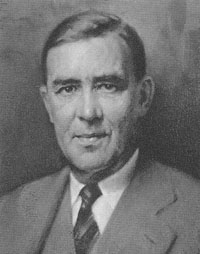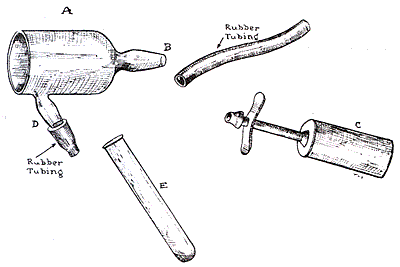Wassermann Reaction – Blackfan
Apparatus for Collecting Infants’
Blood for the Wassermann Reaction

By Kenneth D. Blackfan, M.D.,
Department of Pediatrics
Washington University
St. Louis, Mo.
Am J Dis Child, 4:33-34, 1912
The methods usually employed for obtaining blood from infants are in the majority of cases extremely unsatisfactory. The veins are too small to enter and it is a tedious, difficult and painful procedure to collect the necessary amount of blood by puncturing the fingers or toes.
In European clinics use is made of a suction apparatus. This, in our hands, has proved unsatisfactory in its application to very poorly nourished infants and it is unnecessarily elaborate. The modification herein described is a simple, inexpensive device by which the necessary amount of blood can be obtained easily, with a minimum of discomfort to the patient and in a comparatively short space of time. The apparatus has been in daily use at St. Louis Children’s Hospital and the time spent in collecting the blood averages about two minutes.
The apparatus, as shown in the accompanying illustration, consists of a glass cylinder (A) 1 5/8 inches in diameter; the large end is ground smooth and the other end (B) is drawn out for the attachment of a small hand suction pump (C); an outlet (D) which is fused at an angle to the under surface of the cylinder, one-half inch from the large end, and a collecting tube (E). The collecting tube (E) fits over the outlet (D), the connection being made air-tight by means of a small piece of rubber tubing. The tube in which the blood is collected may be the size which is used in the laboratory test, obviating the necessity of transferring the blood to another tube.
Technic
The technic is as follows: Connect the apparatus for use. The patient may be placed in either the upright or recumbent posture. The most convenient site is on the back just below the angle of the scapula, though any other surface of the body may be used. Having cleansed the area with alcohol and ether, one or two small punctures are made through the skin with a sharp-pointed scalpel or Hagedorn needle and the apparatus is quickly applied. With but little suction force the blood will flow from the wound through the outlet and into the collecting tube. After a sufficient amount has been collected, the tube is taken off, a cotton plug is inserted and the tube containing the blood is set aside until the examination is made. The wound is covered with a collodion dressing and the resulting swelling rapidly subsides with no discomfort to the patient.
Blood may be collected by this method as well from older children and adults, as well as infants, in a much shorter time and with less difficulty than by entering a vein.
The glass apparatus can be made in the laboratory or by a glass blower and the suction pump can be obtained through any surgical supply house.
1806 Locust Street.

The apparatus for collecting blood for the Wasserman reaction. A, suction glass connecting at B with suction pump, C. The blood flows through D, connected by robber stopper with an ordinary test tube E.
Originally transcribed 1/27/2000. Converted to WordPress 8/24/2024.
Last Updated on 08/24/24